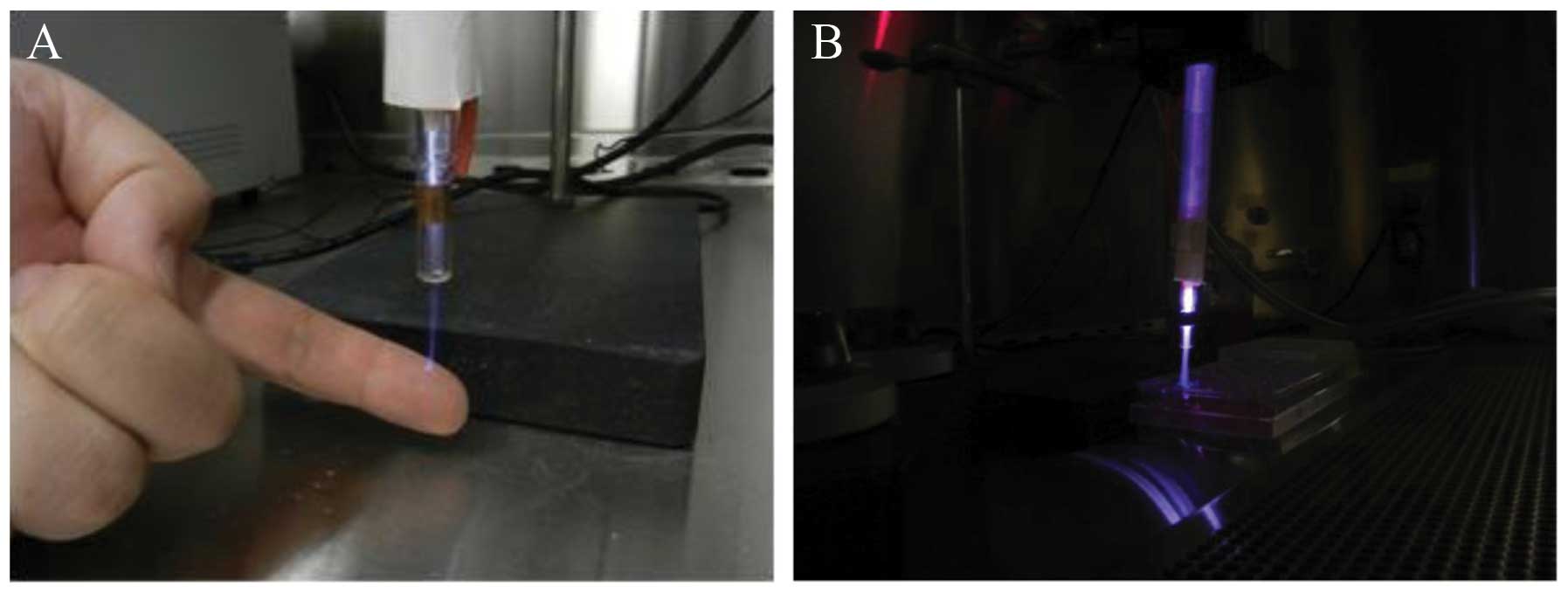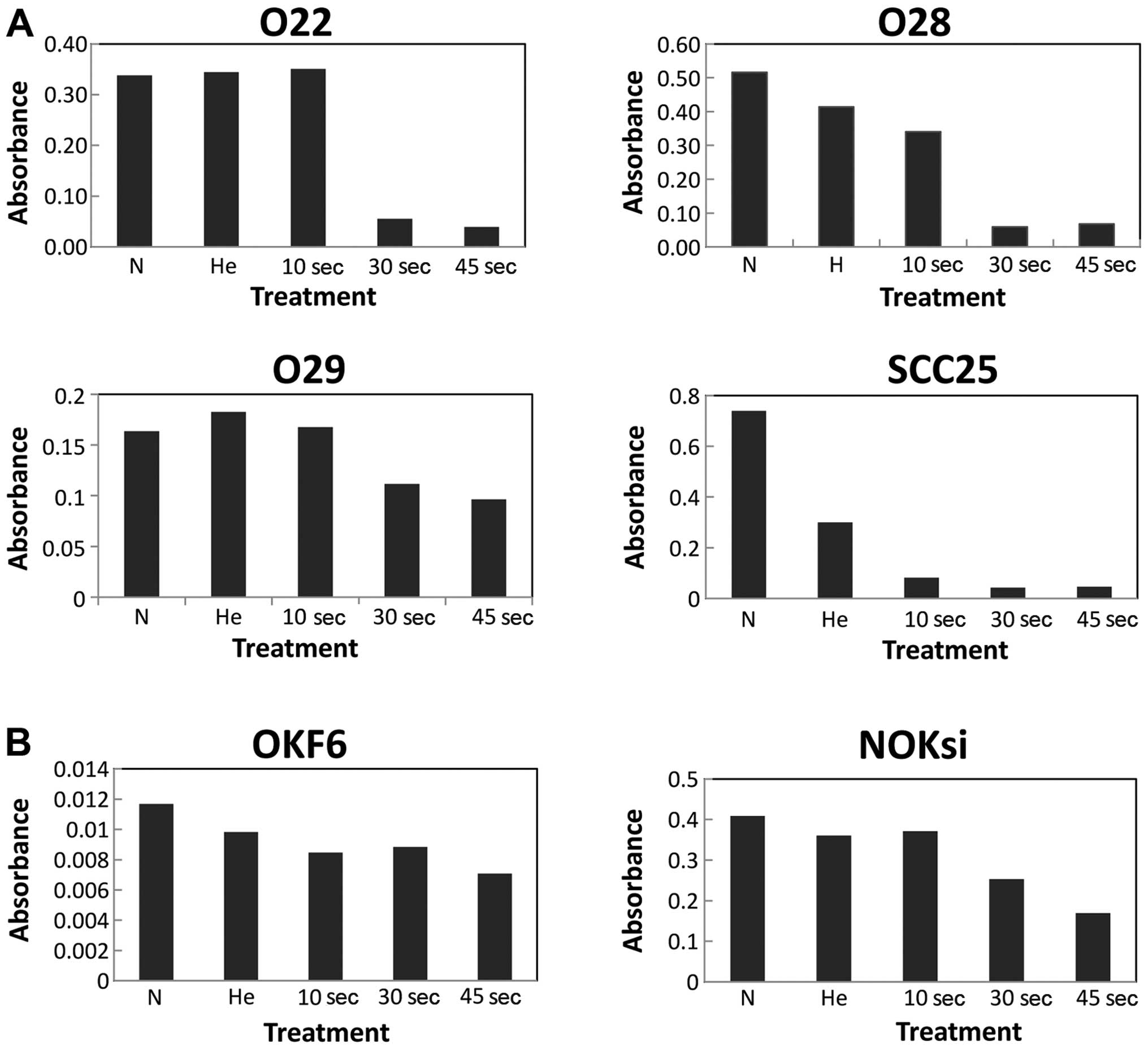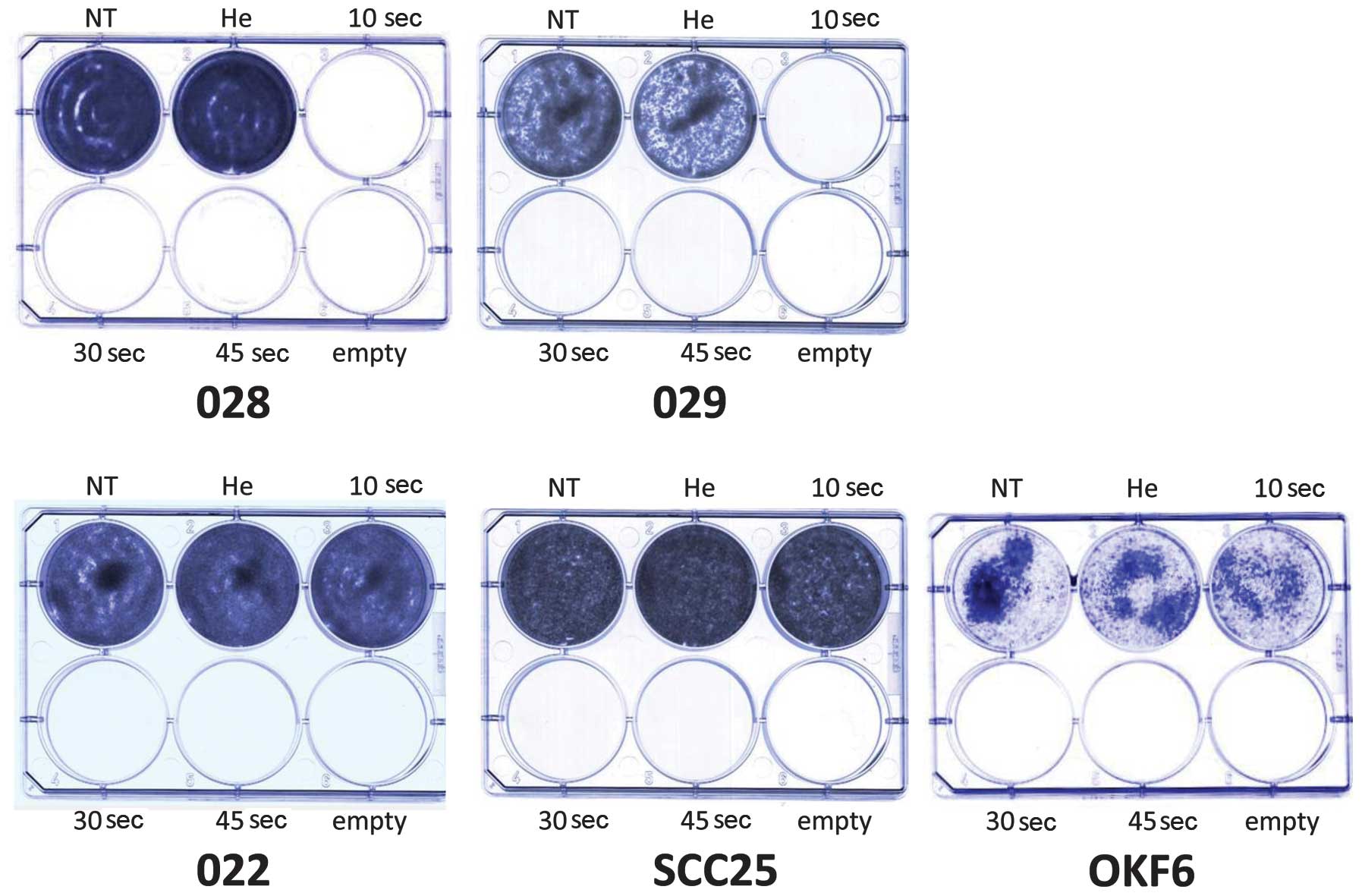|
1
|
Agrawal N, Frederick MJ, Pickering CR, et
al: Exome sequencing of head and neck squamous cell carcinoma
reveals inactivating mutations in NOTCH1. Science. 333:1154–1157.
2011. View Article : Google Scholar : PubMed/NCBI
|
|
2
|
Jemal A, Siegel R, Ward E, et al: Cancer
statistics, 2007. CA Cancer J Clin. 57:43–66. 2007. View Article : Google Scholar
|
|
3
|
Fletcher EV: Epidermal growth factor
receptor inhibitor induces interleukin-6 via NADPH oxidase enzymes
in head and neck cancer cells. Master’s thesis. University of Iowa;
2012
|
|
4
|
Forastiere AA, Goepfert H, Maor M, et al:
Concurrent chemotherapy and radiotherapy for organ preservation in
advanced laryngeal cancer. N Engl J Med. 349:2091–2098. 2003.
View Article : Google Scholar : PubMed/NCBI
|
|
5
|
Hardisson D: Molecular pathogenesis of
head and neck squamous cell carcinoma. Eur Arch Otorhinolaryngol.
260:502–508. 2003. View Article : Google Scholar : PubMed/NCBI
|
|
6
|
Wang M, Holmes B, Cheng X, et al: Cold
atmospheric plasma for selectively ablating metastatic breast
cancer cells. PLoS One. 8:e737412013. View Article : Google Scholar : PubMed/NCBI
|
|
7
|
Shimizu T, Steffes B, Pompl R, et al:
Characterization of microwave plasma torch for decontamination.
Plasma Process Polym. 5:577–582. 2008. View Article : Google Scholar
|
|
8
|
Yonson S, Coulombe S, Léveillé V and Leask
RL: Cell treatment and surface functionalization using a miniature
atmospheric pressure glow discharge plasma torch. J Phys D Appl
Phys. 39:3508–3513. 2008. View Article : Google Scholar
|
|
9
|
Kim JY, Ballato J, Foy P, et al:
Single-cell-level cancer therapy using a hollow optical fiber-based
microplasma. Small. 6:1474–1478. 2010. View Article : Google Scholar : PubMed/NCBI
|
|
10
|
Lupu AR, Georgescu N, Călugăru A, et al:
The effects of cold atmospheric plasma jets on B16 and COLO320
tumoral cells. Roum Arch Microbiol Immunol. 68:136–144.
2009.PubMed/NCBI
|
|
11
|
Lupu AR and Georgescu N: Cold atmospheric
plasma jet effects on V79-4 cells. Roum Arch Microbiol Immunol.
69:67–74. 2010.PubMed/NCBI
|
|
12
|
Moisan M, Barbeau J, Moreau S, et al:
Low-temperature sterilization using gas plasmas: a review of the
experiments and an analysis of the inactivation mechanisms. Int J
Pharm. 226:1–21. 2001. View Article : Google Scholar : PubMed/NCBI
|
|
13
|
Kim JY, Ballato J, Foy P, et al: Apoptosis
of lung carcinoma cells induced by a flexible optical fiber-based
cold microplasma. Biosens Bioelectron. 28:333–338. 2011. View Article : Google Scholar : PubMed/NCBI
|
|
14
|
Panngom K, Baik KY, Nam MK, et al:
Preferential killing of human lung cancer cell lines with
mitochondrial dysfunction by nonthermal dielectric barrier
discharge plasma. Cell Death Dis. 4:e6422013. View Article : Google Scholar : PubMed/NCBI
|
|
15
|
Keidar M, Walk R, Shashurin A, et al: Cold
plasma selectivity and the possibility of a paradigm shift in
cancer therapy. Br J Cancer. 105:1295–1301. 2011. View Article : Google Scholar : PubMed/NCBI
|
|
16
|
Hoffmann M, Bruch HP, Kujath P and Limmer
S: Cold-plasma coagulation in the treatment of malignant pleural
mesothelioma: results of a combined approach. Interact Cardiovasc
Thorac Surg. 10:502–505. 2010. View Article : Google Scholar : PubMed/NCBI
|
|
17
|
Walk RM, Snyder JA, Srinivasan P, et al:
Cold atmospheric plasma for the ablative treatment of
neuroblastoma. J Pediatr Surg. 48:67–73. 2013. View Article : Google Scholar : PubMed/NCBI
|
|
18
|
Volotskova O, Hawley TS, Stepp MA and
Keidar M: Targeting the cancer cell cycle by cold atmospheric
plasma. Sci Rep. 2:6362012. View Article : Google Scholar : PubMed/NCBI
|
|
19
|
Sensenig R, Kalghatgi S, Cerchar E, et al:
Non-thermal plasma induces apoptosis in melanoma cells via
production of intracellular reactive oxygen species. Ann Biomed
Eng. 39:674–687. 2011. View Article : Google Scholar : PubMed/NCBI
|
|
20
|
Vandamme M, Robert E, Lerondel S, et al:
ROS implication in a new antitumor strategy based on non-thermal
plasma. Int J Cancer. 130:2185–2194. 2012. View Article : Google Scholar : PubMed/NCBI
|
|
21
|
Arndt S, Wacker E, Li YF, et al: Cold
atmospheric plasma, a new strategy to induce senescence in melanoma
cells. Exp Dermatol. 22:284–289. 2013. View Article : Google Scholar : PubMed/NCBI
|
|
22
|
Sandulache VC, Ow TJ, Daram SP, et al:
Residual nodal disease in patients with advanced-stage
oropharyngeal squamous cell carcinoma treated with definitive
radiation therapy and posttreatment neck dissection: association
with locoregional recurrence, distant metastasis, and decreased
survival. Head Neck. 35:1454–1460. 2013.
|
|
23
|
Kieft IE, Kurdi M and Stoffels E:
Reattachment and apoptosis after plasma-needle treatment of
cultured cells. IEEE T Plasma Sci. 34:1331–1336. 2006. View Article : Google Scholar
|
|
24
|
Lee HJ, Shon CH, Kim YS, et al:
Degradation of adhesion molecules of G361 melanoma cells by a
non-thermal atmospheric pressure microplasma. New J Phys.
11:1150262009. View Article : Google Scholar
|
|
25
|
Shashurin A, Stepp MA, Hawley TS, et al:
Influence of cold plasma atmospheric jet on surface integrin
expression of living cells. Plasma Process Polym. 7:294–300. 2010.
View Article : Google Scholar
|
|
26
|
Keidar M, Shashurin A, Volotskova O, et
al: Cold atmospheric plasma in cancer therapy. Physics of Plasmas.
20:0571012013. View Article : Google Scholar
|
|
27
|
Vandamme M, Robert E, Pesnel S, et al:
Antitumor effect of plasma treatment on U87 glioma xenografts:
preliminary results. Plasma Process Polym. 7:264–273. 2010.
View Article : Google Scholar
|
|
28
|
Skinner HD, Sandulache VC, Ow TJ, et al:
TP53 disruptive mutations lead to head and neck cancer treatment
failure through inhibition of radiation-induced senescence. Clin
Cancer Res. 18:290–300. 2012. View Article : Google Scholar : PubMed/NCBI
|
|
29
|
Tokumaru Y, Yamashita K, Osada M, et al:
Inverse correlation between cyclin A1 hypermethylation and p53
mutation in head and neck cancer identified by reversal of
epigenetic silencing. Cancer Res. 64:5982–5987. 2004. View Article : Google Scholar : PubMed/NCBI
|
|
30
|
Gu X, Song X, Dong Y, et al: Vitamin E
succinate induces ceramide-mediated apoptosis in head and neck
squamous cell carcinoma in vitro and in vivo. Clin Cancer Res.
14:1840–1848. 2008. View Article : Google Scholar : PubMed/NCBI
|
|
31
|
Burns JE, Baird MC, Clark LJ, et al: Gene
mutations and increased levels of p53 protein in human squamous
cell carcinomas and their cell lines. Br J Cancer. 67:1274–1284.
1993. View Article : Google Scholar : PubMed/NCBI
|
|
32
|
Ho AS, Kraus DH, Ganly I, et al: Decision
making in the management of recurrent head and neck cancer. Head
Neck. 36:144–151. 2014. View Article : Google Scholar : PubMed/NCBI
|
|
33
|
Strojan P, Corry J, Eisbruch A, et al:
Recurrent and second primary squamous cell carcinoma of the head
and neck: when and how to reirradiate. Head Neck. Nov 7–2013.(Epub
ahead of print).
|
|
34
|
Mehanna HM and Ang KK: Head and Neck
Cancer Recurrence: Evidence-based Multidisciplinary Management. 1st
edition. Thieme Medical Publishers, Inc; New York, NY: pp.
3162012
|
|
35
|
Hoffmann TK: Systemic therapy strategies
for head-neck carcinomas: current status. GMS Curr Top
Otorhinolaryngol Head Neck Surg. 11:Doc032012.PubMed/NCBI
|
|
36
|
Bonner JA, Harari PM, Giralt J, et al:
Radiotherapy plus cetuximab for squamous-cell carcinoma of the head
and neck. N Engl J Med. 354:567–578. 2006. View Article : Google Scholar : PubMed/NCBI
|
|
37
|
Ang KK, Harris J, Wheeler R, et al: Human
papillomavirus and survival of patients with oropharyngeal cancer.
N Engl J Med. 363:24–35. 2010. View Article : Google Scholar : PubMed/NCBI
|
|
38
|
Kelloff GJ, Lippman SM, Dannenberg AJ, et
al: Progress in chemoprevention drug development: the promise of
molecular biomarkers for prevention of intraepithelial neoplasia
and cancer-a plan to move forward. Clin Cancer Res. 12:3661–3697.
2006. View Article : Google Scholar : PubMed/NCBI
|
|
39
|
Myers MF, Chang MH, Jorgensen C, et al:
Genetic testing for susceptibility to breast and ovarian cancer:
evaluating the impact of a direct-to-consumer marketing campaign on
physicians’ knowledge and practices. Genet Med. 8:361–370.
2006.PubMed/NCBI
|
|
40
|
Whitworth A: New research suggests access,
genetic differences play role in high minority cancer death rate. J
Natl Cancer Inst. 98:6692006. View Article : Google Scholar : PubMed/NCBI
|
|
41
|
Svatek RS, Lee JJ, Roehrborn CG, Lippman
SM and Lotan Y: The cost of prostate cancer chemoprevention: a
decision analysis model. Cancer Epidemiol Biomarkers Prev.
15:1485–1489. 2006. View Article : Google Scholar : PubMed/NCBI
|


















